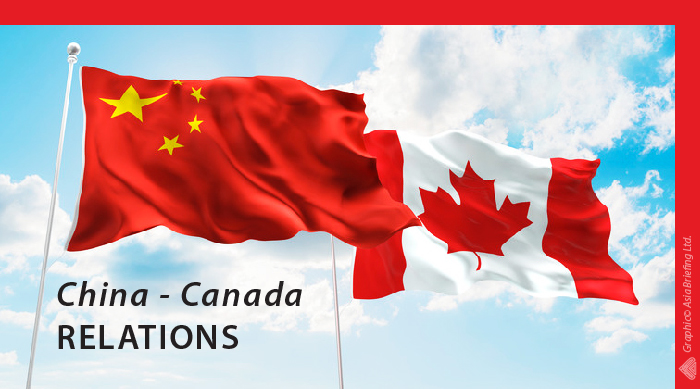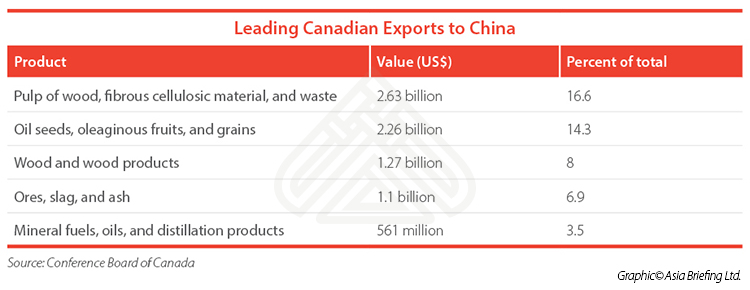China-Canada Relations: A New Economic Partnership?

Chinese Premier Li Keqiang announced the beginning of a new “golden decade” in China-Canada relations when he visited Canadian Prime Minister Justin Trudeau in September 2016.
The trip was the first by a Chinese premier in 13 years, and came only weeks after Trudeau himself paid a visit to China. The “golden decade” has already borne fruit with Canada’s accession to the China-led Asian Infrastructure Investment Bank (AIIB) and the launch of exploratory talks for a free trade agreement (FTA).
The optimistic language surrounding China-Canada relations marked a tonal shift from the previous decade of bilateral relations, when Canada, under the stewardship of Prime Minister Stephen Harper, viewed China largely with suspicion and unease. However, while Trudeau has publicly sought to reengage China, barriers remain in the relationship.
One year into the “golden decade”, how far have China-Canada relations progressed?
Canada’s reengagement with China
Canada’s engagement with China was inconsistent while Harper was prime minister from 2006 to 2015. Prioritizing human rights and security in dealings with China, Harper personally snubbed the Beijing Olympics in 2008, and his administration expressed scepticism over Chinese investments in Canada. After the Chinese state-owned enterprise (SOE) CNOOC controversially purchased Canadian oil and gas company Nexen, the Harper government amended the Investment Canada Act to restrict takeovers by foreign SOEs.
However, after pressure from the business community to deepen ties with China, Canada signed the Foreign Investment Promotion and Protection Agreement (FIPA) with China in 2012, and Toronto became the first RMB trading hub in North America in 2015. Despite increased cooperation, Canada passed on the opportunity to become a founding member of the AIIB when it opened in 2014.
![]() Pre-Investment, Market Entry Strategy Advisory Services from Dezan Shira & Associates
Pre-Investment, Market Entry Strategy Advisory Services from Dezan Shira & Associates
The Trudeau government has publicly stated its intent to engage with China more comprehensively and strategically. Trudeau perhaps has a head start, as his father, Canadian Prime Minister Pierre Trudeau, was instrumental in getting the West to recognize the People’s Republic in the 1960s and 70s. Chinese President Xi Jinping lauded the elder Trudeau for his “extraordinary political vision” when meeting the junior Trudeau for the first time.
The Trudeau government appears to be making good on its promises to engage China. Besides joining the AIIB and entering exploratory FTA talks, the government has approved controversial Chinese investments into sensitive areas.
Most notably, Shenzhen-based Hytera Communications gained approval to purchase Canadian satellite communications company Norsat, which counts US security interests among its clientele. The takeover passed a standard security review, but did not undergo a national security review, despite calls to do so by opposition parties in the Canadian Parliament.
While increased engagement with China can be contentious with the US, Canada’s biggest ally, Canadians are growing more receptive to the idea. Spurred by growing isolationism in the US and Europe, support for an FTA with China has grown from just 36 percent in 2014 to 55 percent in 2017, according to a survey commissioned by the Asia Pacific Foundation.
As Canada is in the process of renegotiating the North America Free Trade Agreement (NAFTA) with the US and Mexico, strengthening its economic relationship with China will help diversify and mitigate risk. For Gary Shaben, Director of Global Business Development at Dezan Shira & Associates, this should not just be a bargaining tactic vis-à-vis NAFTA, but a long-term strategy of engagement.
Shaben, a Canadian expatriate based in Shanghai, said, “Under the Harper administration, Canadian trade and investment into China lagged well behind that of other countries. The vast majority of CDIA [Canadian Direct Investment Abroad] targets US markets, and many believe that Canada relies too heavily on trade with the US, which accounts for around 75 percent of its exports, compared to just 4.3 percent to China.”
Shaben continued, “With NAFTA under review, and global oil prices remaining low, the Canadian economy seems to be in need of further international market and sector diversification, and China may very well offer Canadian companies some important opportunities.”
Canadian trade and investment opportunities
China’s main motivation in pursuing an FTA with Canada is to secure energy, food, and other commodities. Canada is rich in natural resources, which dominate its exports to China.
Commodities and agricultural goods such as timber, canola, metals, and biotechnology products will continue to be highly sought after by China. China is already the world’s largest importer of logs and pulp of wood, and demand is expected to grow despite its generally slowing appetite for commodities.
By 2025, the China Timber Supply Outlook projects China’s imports of timber and forest products to increase by 60 million cubic metres to account for about 12 percent of the world’s total timber harvest. Canada is rich in forest products, which make up about seven percent of the country’s total exports.
Although China continues to drive demand for many commodities, as its industrial boom ends, and its economy restructures, Canada’s economic relationship will need to shift in kind. Whereas China traditionally sought Canada’s commodities to supply its massive construction and industrial expansion, now Canadian technology and expertise is in demand as China attempts to move up the value chain.
Take the artificial intelligence (AI) industry, for example. Despite its relatively small population, Canada’s 80,000 AI personnel are the third most in the world, according to a recent LinkedIn report. Meanwhile, China only has 50,000 AI personnel despite its huge population and strong government support for the industry.
Canadian firms in such areas can leverage their technology and expertise to scale up in emerging industries in China and utilize government incentives.
China can also benefit from Canadian expertise in areas where it faces immense domestic challenges. For instance, the Chinese government is investing heavily in cleantech to solve its myriad environmental issues, and China’s rapidly aging population is increasing demand for elder care services and advanced medical technology.
Daniel Schaefer, a Canadian expatriate who serves as Marketing & Operations Associate at Dezan Shira & Associates, notes, “As Canada is a medium-sized economy with tons of innovative players, China is an attractive market for Canadian companies to enter. Canadian cleantech companies focusing on renewable energy, engineering advances, battery tech, and solar power tech find viable opportunities in China’s push to use new forms of renewal energy.”
However, while Canada has room to break new ground in higher value technology and service sectors, the country still has untapped opportunities in its traditional resource-based industries, though largely through consumer goods, rather than pure commodities. Shaben remarks, “Food and beverage is Canada’s second largest manufacturing sector. Its strengths in agricultural and health-based products align well with Chinese demand.”
![]() RELATED: China-Mongolia Relations: Opportunities and Challenges
RELATED: China-Mongolia Relations: Opportunities and Challenges
Canadian businesses can capitalize
China and Canada are highly complementary economies.
China needs Canada’s natural resources and technical expertise, while Canada needs China’s affordable manufactured products and access to its vast consumer market. Further, deepening bilateral trade and investment with China would help Canada reduce its reliance on an increasingly unpredictable US.
Under the Trudeau government, Canada’s relationship with China has become a higher priority. However, if China and Canada are in the early stages of a new “golden decade”, Canada needs a more consistent and expansive approach to China than the hot and cold approach of the past decade.
If an FTA comes to fruition, it will be years before negotiators agree upon the terms and the agreement takes effect. In the meantime, Canadian businesses can capitalize on emerging opportunities in the Middle Kingdom.
|
China Briefing is published by Asia Briefing, a subsidiary of Dezan Shira & Associates. We produce material for foreign investors throughout Asia, including ASEAN, India, Indonesia, Russia, the Silk Road, and Vietnam. For editorial matters please contact us here, and for a complimentary subscription to our products, please click here. Dezan Shira & Associates is a full service practice in China, providing business intelligence, due diligence, legal, tax, IT, HR, payroll, and advisory services throughout the China and Asian region. For assistance with China business issues or investments into China, please contact us at china@dezshira.com or visit us at www.dezshira.com
|

Dezan Shira & Associates Brochure
Dezan Shira & Associates is a pan-Asia, multi-disciplinary professional services firm, providing legal, tax and operational advisory to international corporate investors. Operational throughout China, ASEAN and India, our mission is to guide foreign companies through Asia’s complex regulatory environment and assist them with all aspects of establishing, maintaining and growing their business operations in the region. This brochure provides an overview of the services and expertise Dezan Shira & Associates can provide.
An Introduction to Doing Business in China 2017
This Dezan Shira & Associates 2017 China guide provides a comprehensive background and details of all aspects of setting up and operating an American business in China, including due diligence and compliance issues, IP protection, corporate establishment options, calculating tax liabilities, as well as discussing on-going operational issues such as managing bookkeeping, accounts, banking, HR, Payroll, annual license renewals, audit, FCPA compliance and consolidation with US standards and Head Office reporting.
Payroll Processing in China: Challenges and Solutions
In this issue of China Briefing magazine, we lay out the challenges presented by China’s payroll landscape, including its peculiar Dang An and Hu Kou systems. We then explore how companies of all sizes are leveraging IT-enabled solutions to meet their HR and payroll needs, and why outsourcing payroll is the answer for certain company structures. Finally, we consider the potential for China to emerge as Asia’s premier payroll processing center.
- Previous Article Internal Control for Day-to-Day Operations in China
- Next Article Revitalizing China’s Rust Belt: Incentives for Businesses and Expats































